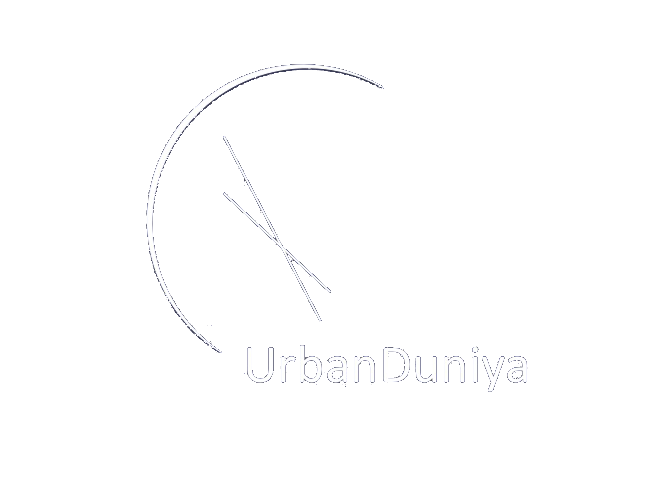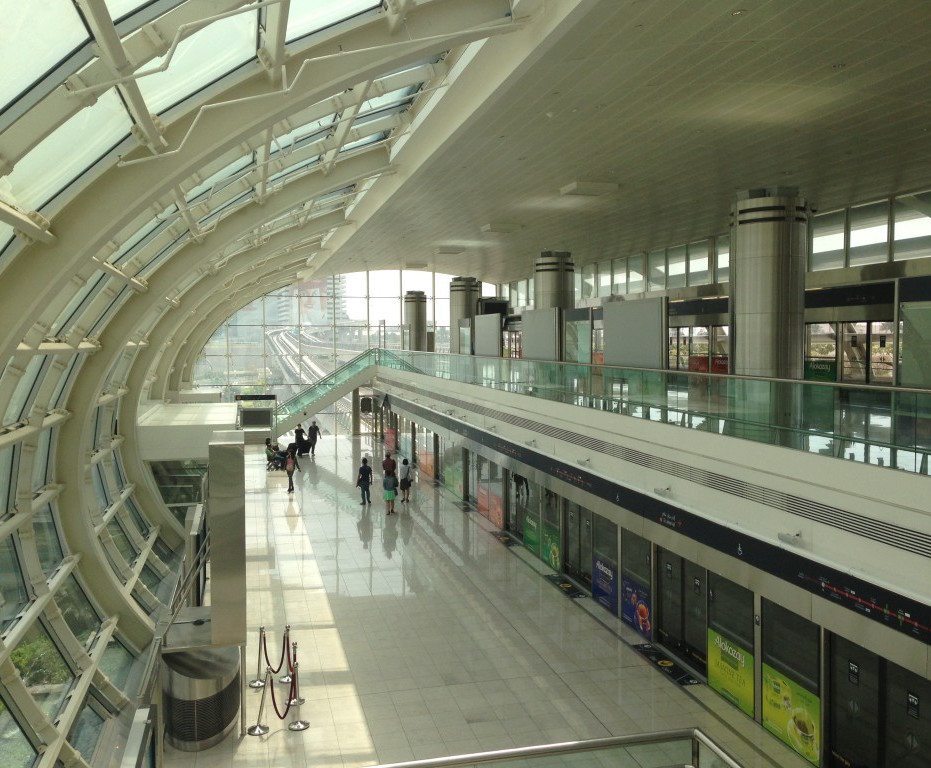
by Tim Blight | Apr 13, 2016 | Lounge (The City Life)
Sydney’s second airport
This is part two of an ongoing series about building Sydney; the infrastructure boom that is changing the harbour city’s future. We started in January with a look at This part two of an ongoing series about building Sydney; the infrastructure boom that is changing the harbour city’s future. We started in January with a look at WestConnex, now we continue with the concern that Sydney’s new international airport may not have a rail link when it opens.WestConnex, now we continue with the concern that Sydney’s new international airport may not have a rail link when it opens.
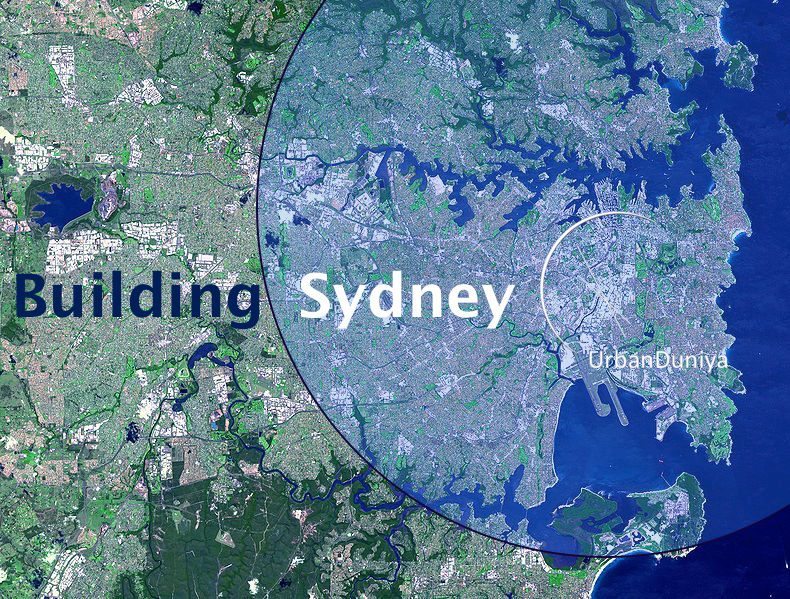
Sydney’s second airport has been given the green light by both state and federal authorities. Decades after the debate began, a large tract of land at Badgery’s Creek has been selected as the location for what is now being called Western Sydney Airport (airport code: SWZ). The airport is to be built in phases; construction is to begin this year, and phase one is to start operations around 2025.
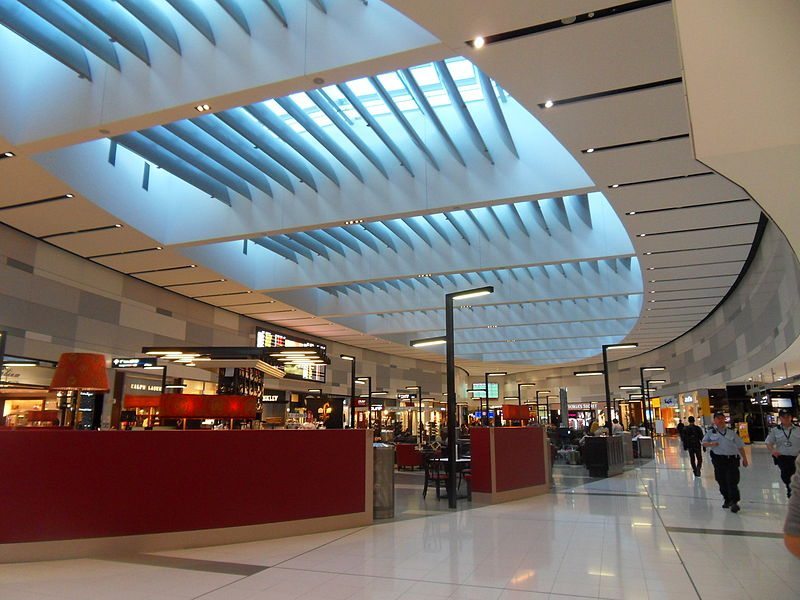
Sydney Kingsford Smith’s international terminal (Image: Mw12310, Wikimedia Commons)
44 kilometres west of Sydney’s city centre, the airport will be linked to the city by a network of roads;
- a ‘spur’ motorway, linked to the M7 which lies 14 kilometres to the east. This will be known as the M12, or Western Sydney Airport Motorway.
- an upgraded Northern Road, linking the airport to Narellan in the south, and Penrith to the north. This corridor is eventually to be developed as the M9, or Outer Ring Road, once warranted by Sydney’s suburban development.
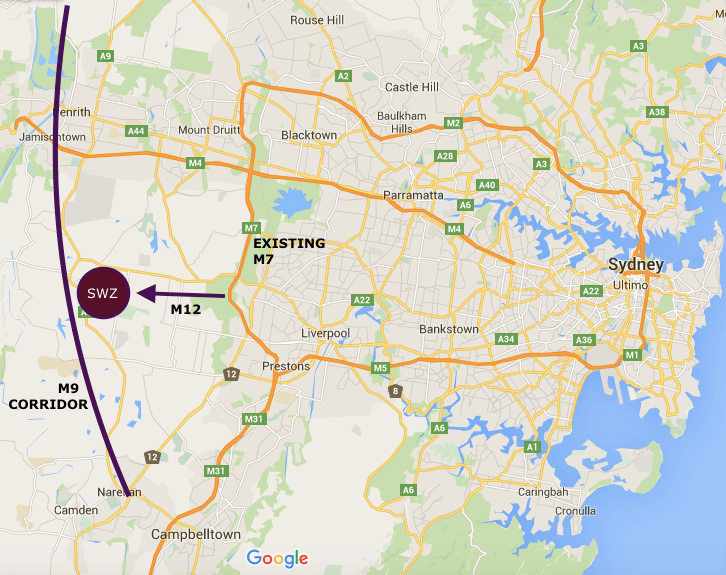
(original image: Google Maps)
What is clearly missing from these plans is the rail link that most cities around the world are now rushing to build to their existing airports. Melbourne is talking about it, Delhi and Tokyo have done it, and Athens managed it for the Olympics in 2004.
And this is just the beginning; the world’s largest and busiest airports all have rail connections to the cities which they serve; think London, Paris, New York City and Moscow. Cities who caught up with infrastructure, like Dubai and Tehran, have also built or are building metro rail to the airport.
Moreover, airports which were built later, like Bangkok’s Suvarnabhumi Airport, Kuala Lumpur International and Hong Kong International were all built with mass public transport in mind.

One of the Dubai Metro’s airport stations
So why not Sydney? While it’s Sydney’s airport will open in phases, surely there is an argument to support opening the airport with public transport in place to begin with. Australian Prime Minister Malcolm Turnbull has commented that rail should be a part of the development of Sydney’s new airport, touching off a state government study which is ongoing. However the need for a rail link for the airport when it opens is arguably a foregone conclusion – a question of “what” or “how”, rather than “if”.
As has already been identified, an extension on the one year old South West Rail Link would be one possible solution. It currently terminates at Leppington, some 15 kilometres south east of the airport site. An extended South West Rail Link could connect Sydney’s new airport directly to the existing Airport and East Hills Line, allowing travel from Badgery’s Creek to the city in under an hour. But is this sufficient?
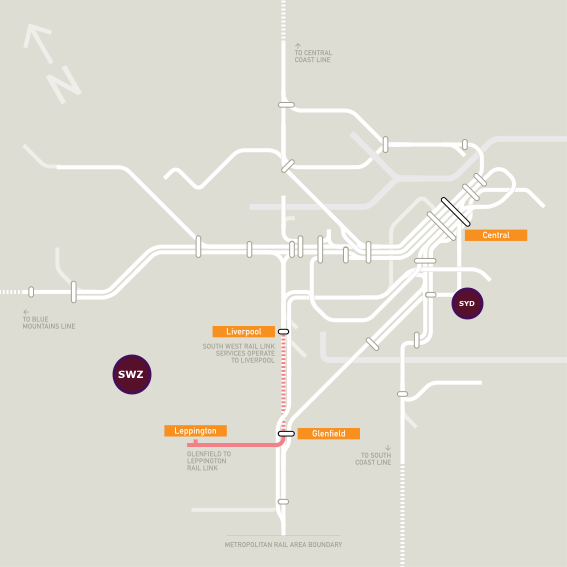
South West Rail Link, highlighted as part of Sydney Trains’ network. (Original image: Mqst north)
- If you were arriving at Western Sydney Airport, would you want to share the already overcrowded rail network with regular commuters all the way through Liverpool, Revesby, Wolli Creek and into the city?
- Will the trains on this route be equipped with appropriate luggage stowing areas? (Something sorely lacking from the current trains operating through the Kingsford Smith airport stations).
- And if you were arriving at Western Sydney Airport and transferring to a flight at Kingsford Smith (or vice versa), could you depend on Sydney Trains in their current state to get your between the two airports in a timely manner?
Surely a dedicated, fast train shuttle service on the route Western Sydney Airport – Kingsford Smith Airport – Sydney City, with the required onboard luggage stowing facilities, would be the ideal solution, and not too difficult to achieve. The train would be fast, reliable, and only make three stops; the two airports (for those transferring) and the CBD. City centre check-in facilities could also be offered, much like what is available in Hong Kong.
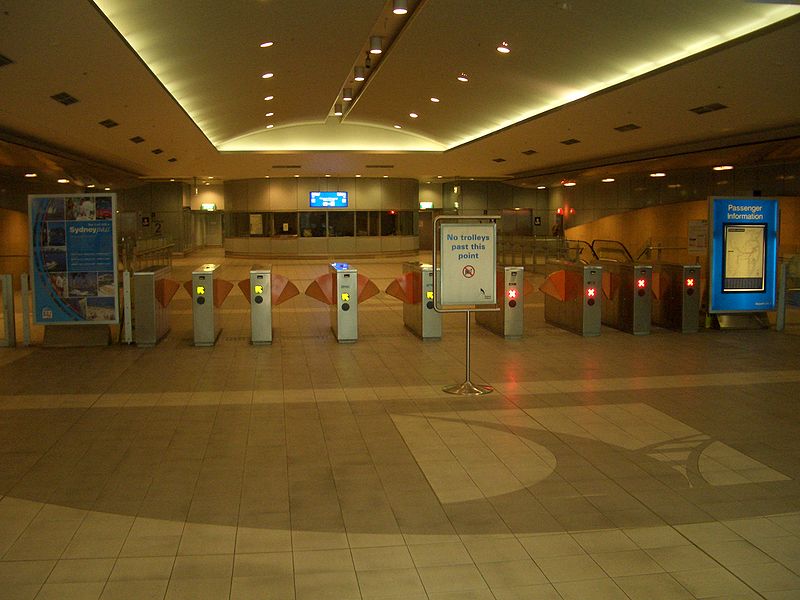
International Terminal Airport Link Station, Sydney (Image: J Bar, Wikimedia Commons)
These are all important questions to ask as the Western Sydney Airport rail study continues – and it seems I’m not the only one asking these questions. Kingsford Smith Airport has suffered from stop-gap measures since the 1980s to extend its life span (and delay the inevitable). What we ended up with was the expensive, underground and already congested Eastern Distributor, and the privately-owned and strangely underutilised (mismanaged?) Airport Link.
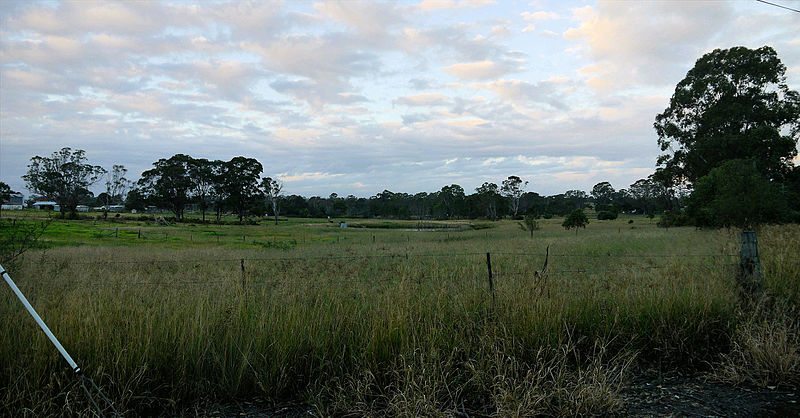
Western Sydney Airport site, Badgery’s Creek (Image: Advanstra, Wikimedia Commons)
Lack of planning and foresight continues to dog Kingsford Smith airport. Badgery’s Creek is a clean slate – why not try and get this one right?
Does Sydney’s second airport need a rail link already built when it opens? Comment below!
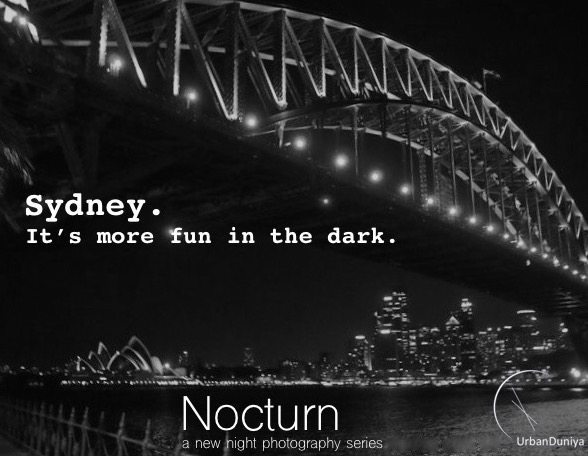
by Tim Blight | Mar 26, 2016 | Gallery
Nocturn: Sydney
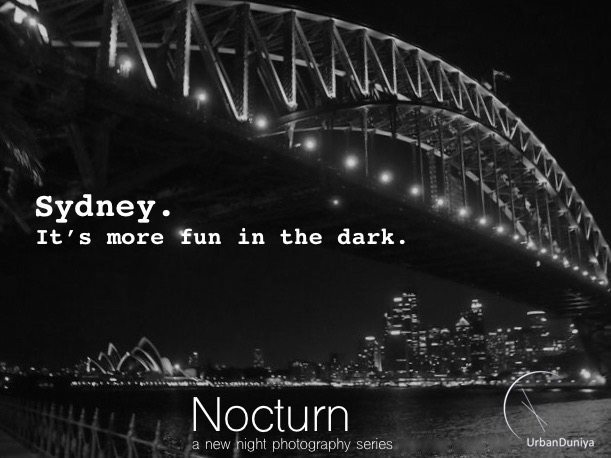
Some of the most amazing and intriguing sights in our cities are only seen at night, when a lot of us are tucked away in bed, fast asleep. Nocturn is a new night photography series on UrbanDuniya, shining the light on the cities we call home, long after most people have fallen asleep.
In November we started with Chennai, and in January we featured Melbourne. Today we continue with Sydney, Australia’s international harbour city.
See Sydney: it’s more fun in the dark.
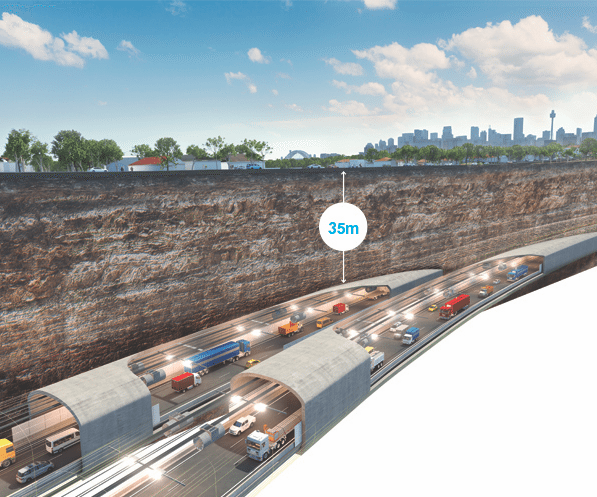
by Tim Blight | Jan 13, 2016 | Lounge (The City Life)
In the first of the Building Sydney series for 2016, I deliver an impartial analysis of the major infrastructure projects underway in the cities we call home. Today, we begin with WestConnex in Sydney, a 33 kilometre, $15 billion network of motorways in Sydney’s inner west and southwest, due for completion in stages between 2019 and 2023.

Sydney’s WestConnex: The Grand Plan
Ever since its announcement in late 2012, Sydney’s WestConnex motorway has been controversial. As visionary as it is a throwback, WestConnex is in fact the latest name (and probably the one that will stick) given to a network of motorways that have been under consideration to varying degrees since the 1960s.
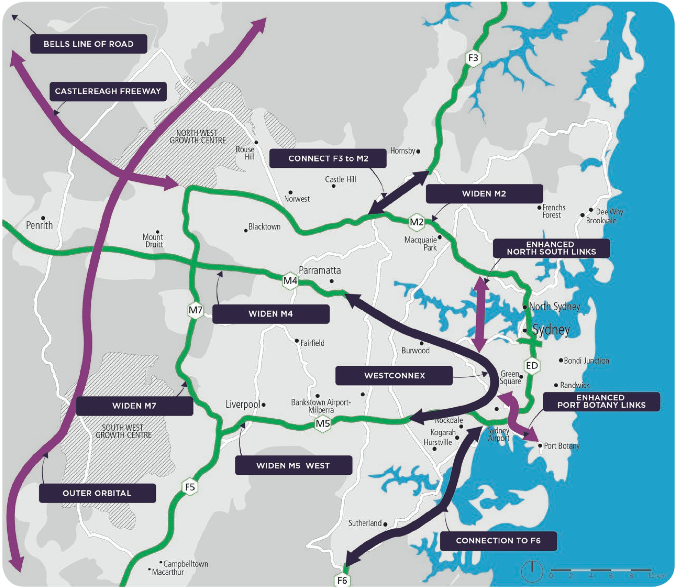
Sydney’s long term road transport plan (Image: Sydney’s Long Term Transport Master Plan, NSW Government, December 2012)
WestConnex is mapped out in three stages, but is actually part of a much grander plan for Sydney’s road infrastructure for the future. Dialogue surrounding WestConnex has so far been dominated by anti-road, pro-public transport sentiment, or pro-road and anti-public transport support. What doesn’t seem to have gained much currency is the idea of a dual solution, requiring huge investment, but potentially preparing Sydney with both public transport and efficient roads for a great future.
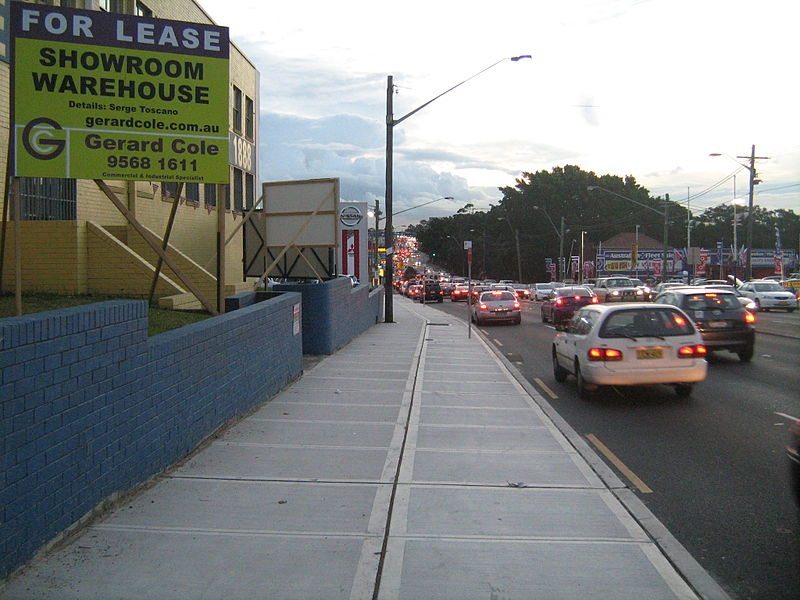
Parramatta Road near Burwood (Image: Wikimedia Commons)
The necessity of a road linkage
In the first stage of the WestConnex plan the existing M4 will feed directly into twin tunnels near Homebush. The tunnels will be 5.5 kilometres long, and known as the M4 East (as they are, effectively, an eastern extension of the M4 which currently terminates at Strathfield). Apart from the existing interchange at Concord Road, there will be no on-ramps or off-ramps between there and the end of it, at City West Link near Ashfield. City West Link is an arterial-road standard road, easily upgraded to motorway standard, which links Ashfield to the Western Distributor near the CBD, and then onwards over the Sydney Harbour Bridge.
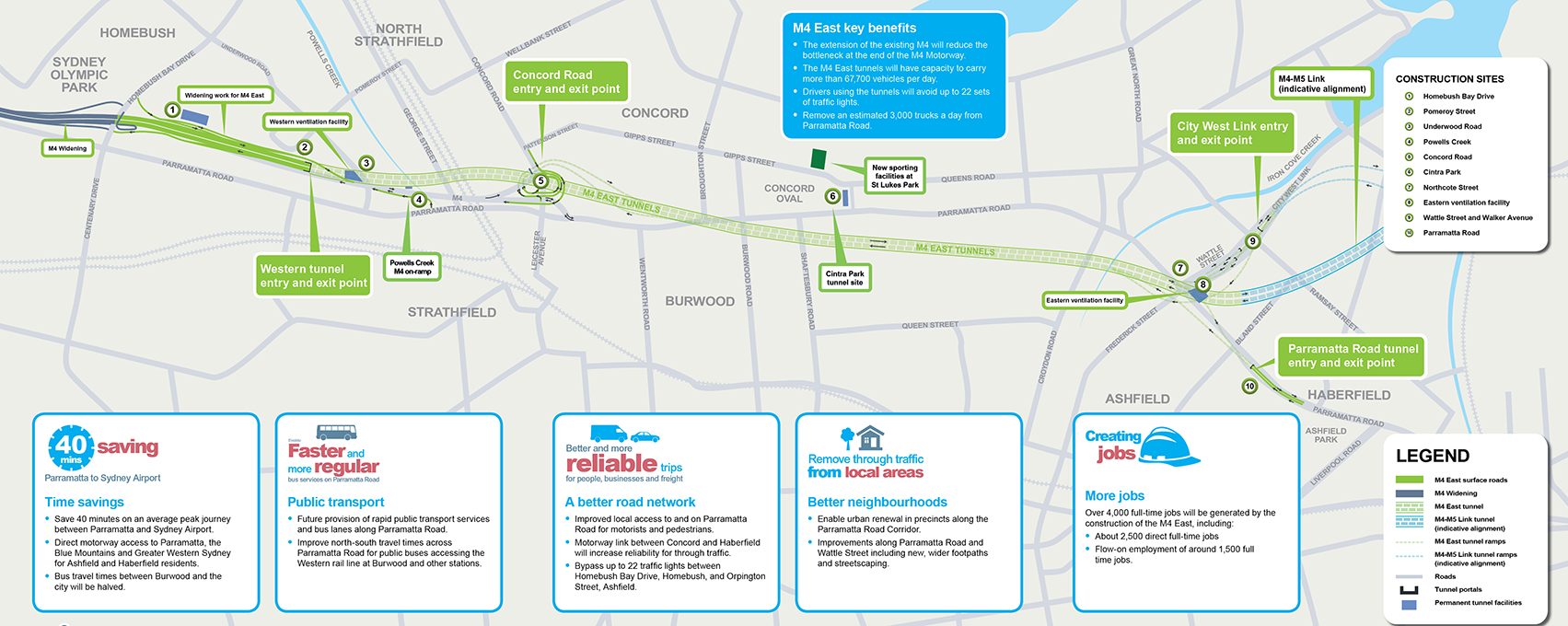
M4 East Map (Image: WestConnex)
Environmental concerns aside, there is reason to believe that WestConnex will not solve the problem of traffic congestion on east-west roads from Sydney’s CBD in the long term. As with all roads, they are often filled to capacity within years, if not a couple of decades of their construction; as a result, major increases to public transit capacity must be considered alongside the road project, which is due to break ground in the middle of this year.
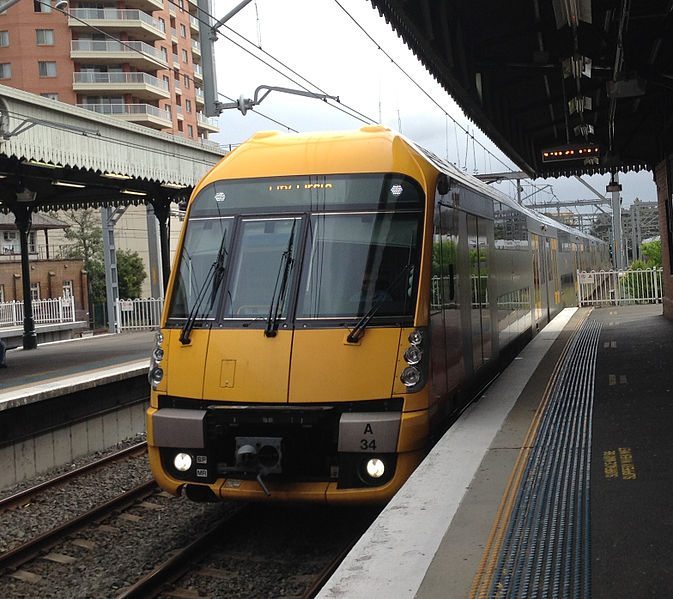
Sydney Train at Strathfield Station (Image: EurovisionNim, Wikimedia Commons)
Clearly, a large proportion of commuters travelling on the east-west axis have journeys that originate in the vicinity of Parramatta, which is often touted as the CBD of a future Western Sydney metropolitan area. More commuters still live in regions beyond Parramatta, which would ostensibly become satellite suburbs and towns of the Western Sydney metropolis (places like Penrith, Rouse Hill, Liverpool and Campbelltown). It would therefore make sense for Parramatta, apparent future employment hub of Western Sydney, to also become something of a transport hub, with light rail and bus options radiating out from the centre; indeed, plans for this are already underway.
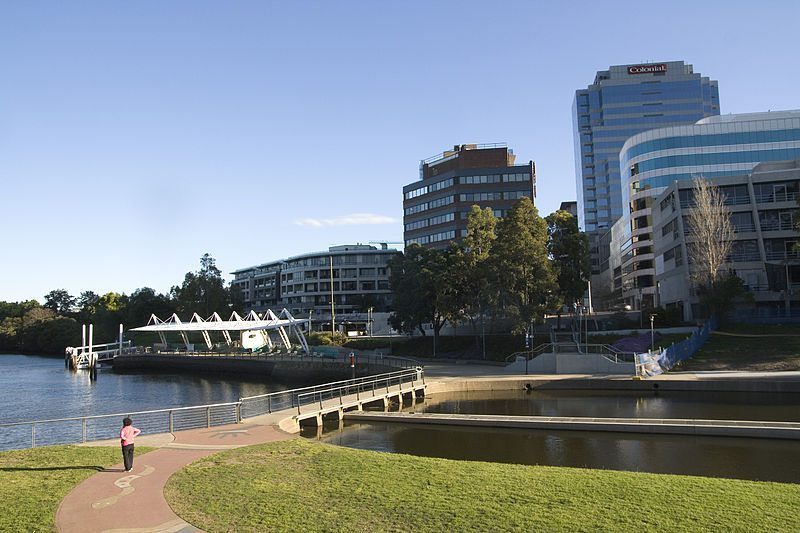
Parramatta CBD (Image: Maksym Kozlenko, Wikimedia Commons)
Heavy rail for the suburbs, metro rail for the ‘inner ring’
Presumably what will be required, then, is high speed, high capacity and high frequency linkages between Sydney’s old CBD and the new one at Parramatta. The existing rail network is able to do this, however currently serves the inner west as well as Parramatta and beyond. What could be done, however, is to utilise Sydney’s forthcoming rolling stock of metro trains on inner west lines, reserving the higher capacity existing trains to serve the outer suburbs. This, in effect, would be an extension of the current plan to replace the Bankstown Line trains with a metro-style fleet. The effect could be enhanced with further light rail options above ground in the inner west and east.
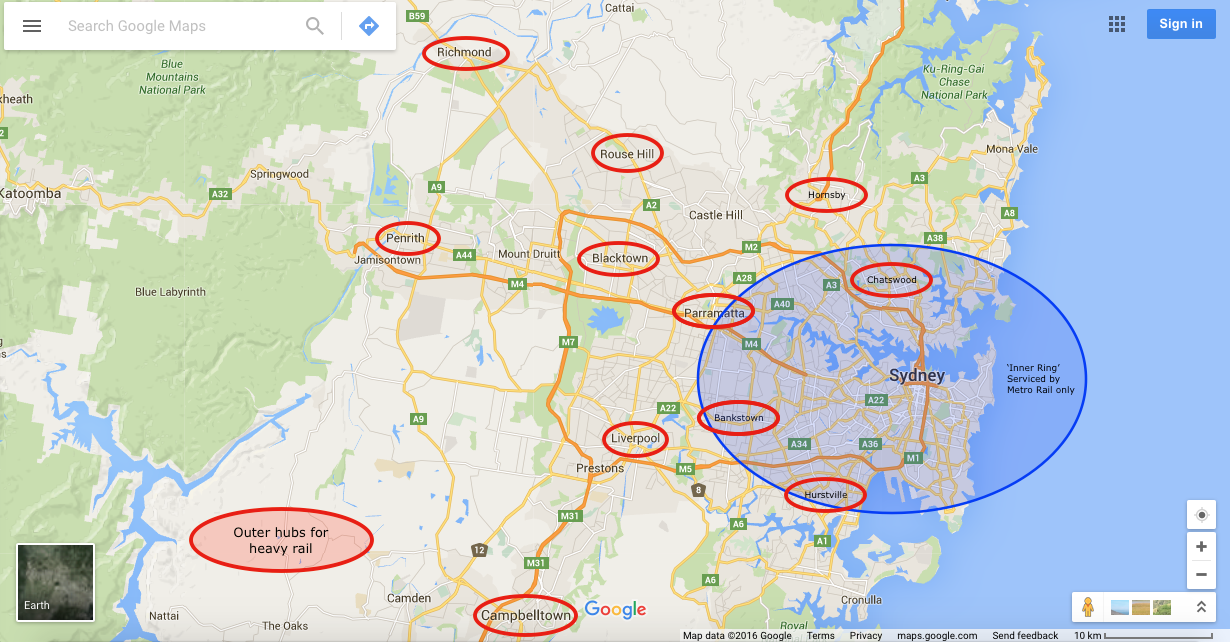
(Map: Google Maps)
What this would mean is a shift in thinking from heavy rail being the prime mover of Sydneysiders, to being a long-distance option between major points like Parramatta, Blacktown and Penrith or Bankstown, Liverpool and Campbelltown. Intermediate stops (like Seven Hills, Toongabbie, Mount Druitt or Werrington) would receive services, but the “inner ring” (i.e. – Central to Bankstown, or Central to Parramatta) would be served exclusively by frequent, high capacity metro style trains. This is an emulation of the European, and increasingly the Asian model of infrastructure development, and would buy years of additional value on the soon to be constructed M4 East.
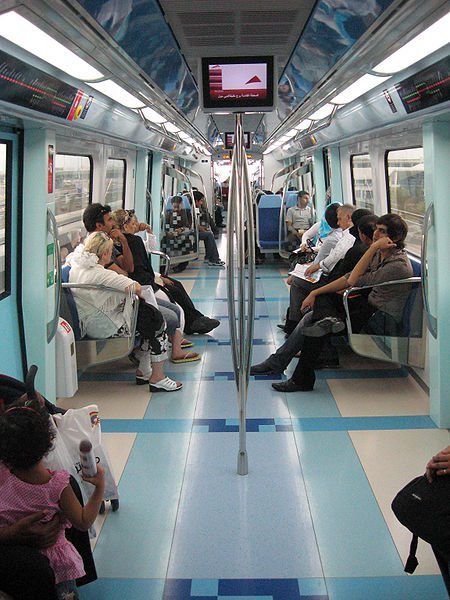
Dubai’s new metro trains. Limited seating means high capacity (standing passengers take up less space than seated ones), ideal for fast, short inner city trips (Image: Robert Schediwy, Wikimedia Commons)
It’s worth remembering that the second stage of WestConnex is the duplication of the two M5 East tunnels, opened in 2002, and already filling up with cars, trucks and sundry. As if to acknowledge the deficiencies in the 2002 development, WestConnex Stage 2 has even been given the moniker “The New M5”. The need for a second pair of tunnels (that’s right, four in total) was announced in 2012 with the initial WestConnex proposal; just ten years after the original road opened, and that was before major development of the “South West Growth Corridor” got underway. At that same rate of growth, without being supplemented by a serious investment in public transport, the M4 East could require expensive duplication by 2029.
Overall, an integrated solution of public transport and roads is the kind of grand plan that Sydney often wishes had been implemented 50 to 100 years ago (Cahill Expressway anyone? Town Hall station crowded enough?). It would also dovetail with plans for Western Sydney’s development in conjunction with a new airport, as well as relieve pressure on the next stages of WestConnex, still under investigation.
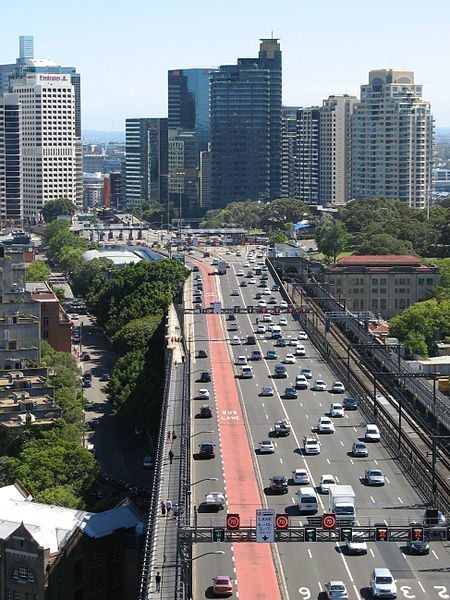
Traffic on the Sydney Harbour Bridge (Image: Mitch Ames, Wikimedia Commons)
The Grand Plan
Stages 2 and 3 of WestConnex are already in the planning stage. Stage 3 envisions an extension of Stage 2 beyond Kingsford Smith Airport and up into the inner city, eventually joining the end of the M4 East. This would be designed to relieve pressure on inner city roads, particularly on the north-south axis between Kingsford Smith Airport and the inner west. It would also, indirectly, relieve pressure on the Eastern Distributor through Moore Park, by providing an alternative route by which to get to the city and beyond.
In the much longer term, the north-south link will be accentuated and extended in the form of the F6 extension (from Waterfall to the airport) and the Western Harbour Tunnel, a second harbour road tunnel to complement the Sydney Harbour Tunnel.
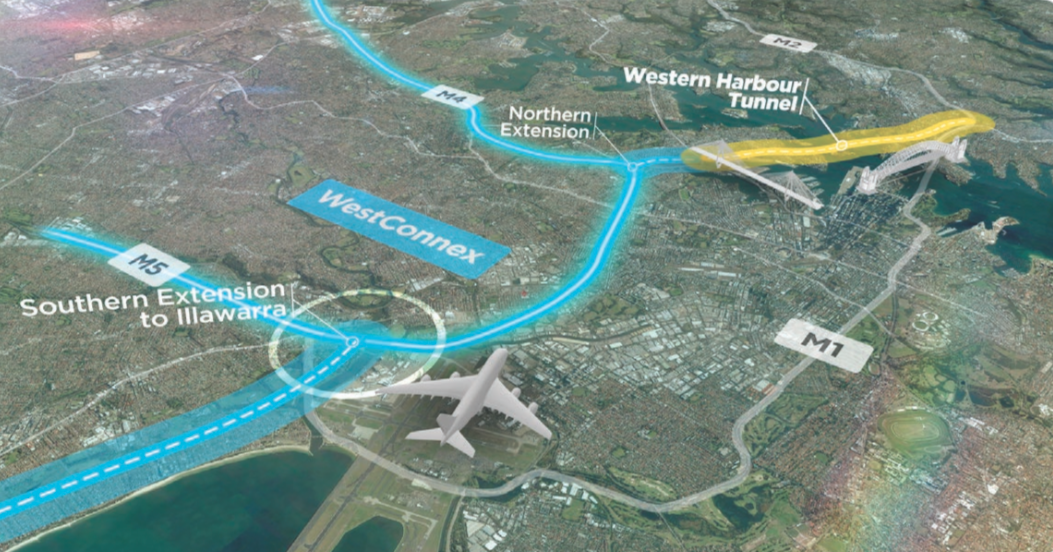
(Image: WestConnex)
While the Western Harbour Tunnel and F6 Extension are planned in the longer term (at least a decade or more away), WestConnex’s Stage 3 is not; in fact Stage 2 is due to start construction this year, and will be built to link directly into Stage 3 when it begins construction in 2019.
WestConnex is, if anything, inevitable; the need for additional road transport linkages in Sydney’s inner west (and particularly along Parramatta Road) were identified years ago. However it has taken years to get to this point, where building is being fast-tracked due to necessity, particularly in the case of the New M5. The state and federal governments must supplement the developments with public alternative transport options, and not allow WestConnex (and especially the M4 East), require duplication just over a decade from now.
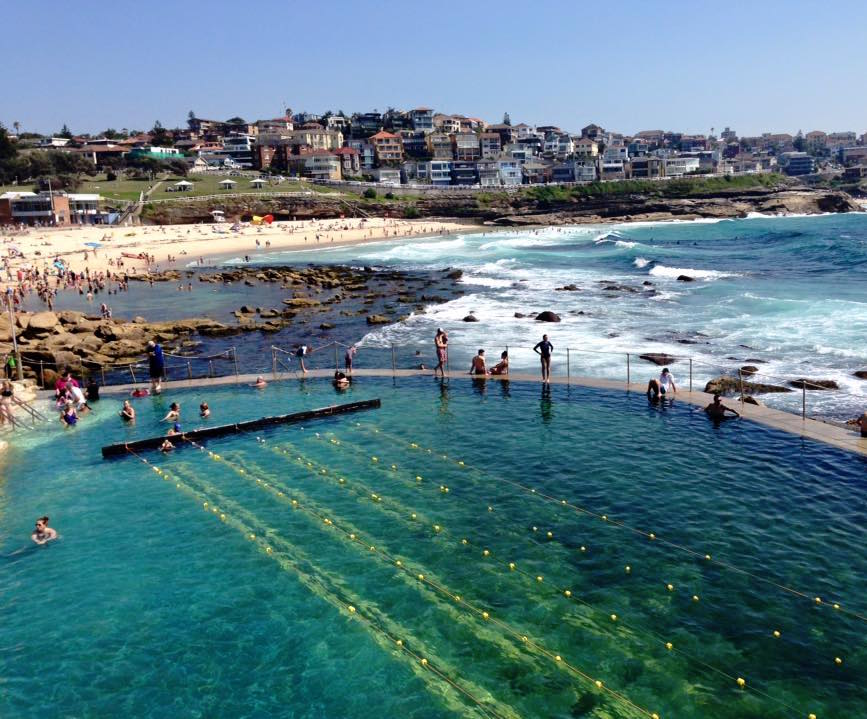
by Tim Blight | Jan 2, 2016 | Lounge (The City Life)
Sydney’s best swimming pools
Last month I posted a summary of an old series, Sydney’s best beaches. While Sydney is blessed with some incredible natural stretches of sand and surf, they’re not the only places to cool off this summer. In fact Sydney is home to a smorgasbord of beautiful swimming pools! From the humble rockpools hewn out of beach headlands to high tech aquatic leisure parks, here in no particular offer are Sydney’s best swimming pools!
North Sydney Olympic Pool
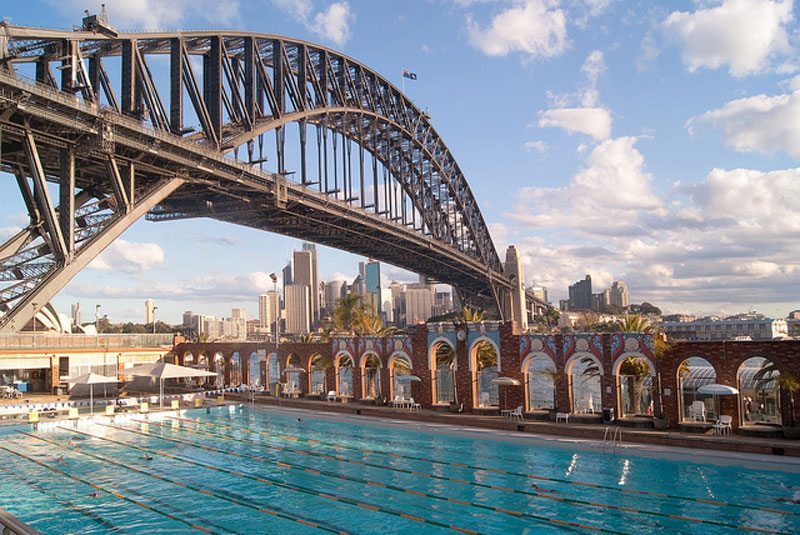
North Sydney Olympic Pool (Image: Yeeyi)
Let’s begin with the iconic North Sydney Olympic Pool. It was built in 1936 and in 1938 hosted the swimming events at the Empire Games, a forerunner to the Commonwealth Games. Nothing is quite as “Sydney” as swimming under the harbour bridge at North Sydney Olympic Pool.
Tip: The restaurant here is pretty good too!
Entry: $7.50
Greenwich Baths, Greenwich
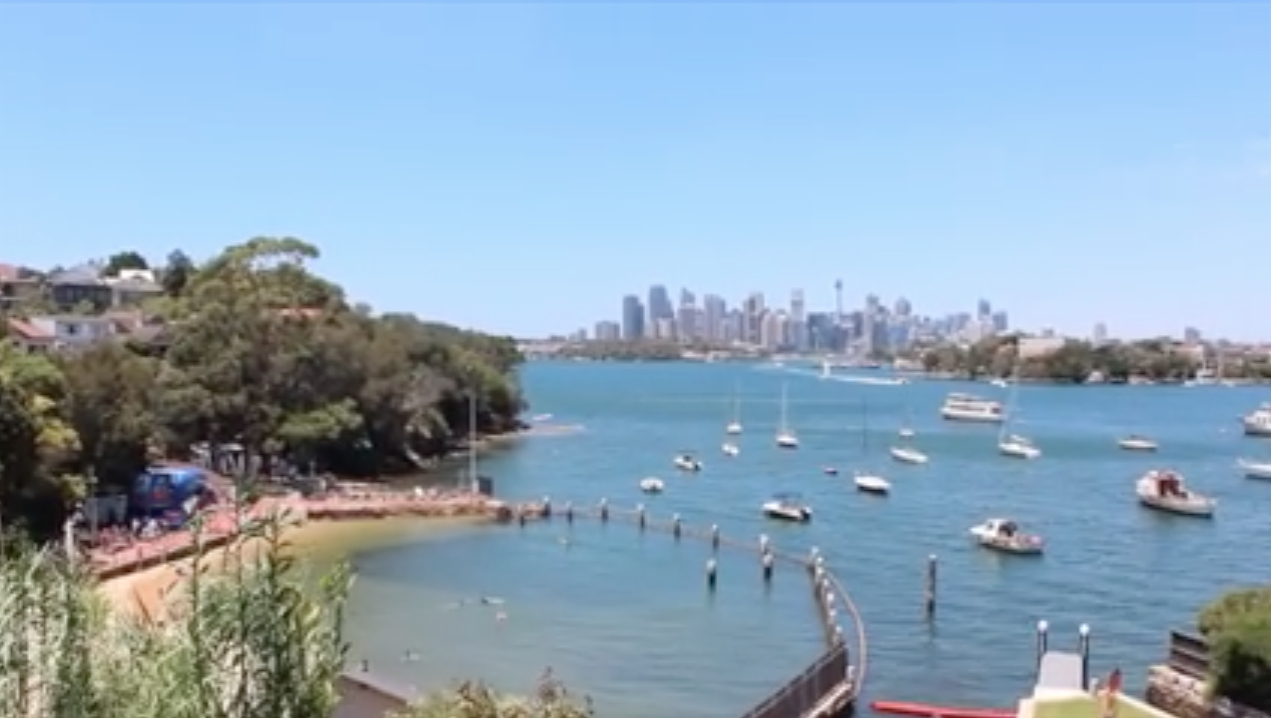
Greenwich Baths
Tucked away in an inlet in northern Sydney harbour, and hidden by foliage, is Greenwich baths. Given the location, you would be forgiven for thinking this is a skinny-dipping hotspot, and while more than a few nocturnal swimmers have been caught with their pants down, by day this is a strictly family affair.
Tip: Not the place to bring a football and stereo system
Price: $4
Andrew “Boy” Charlton, Wooloomooloo
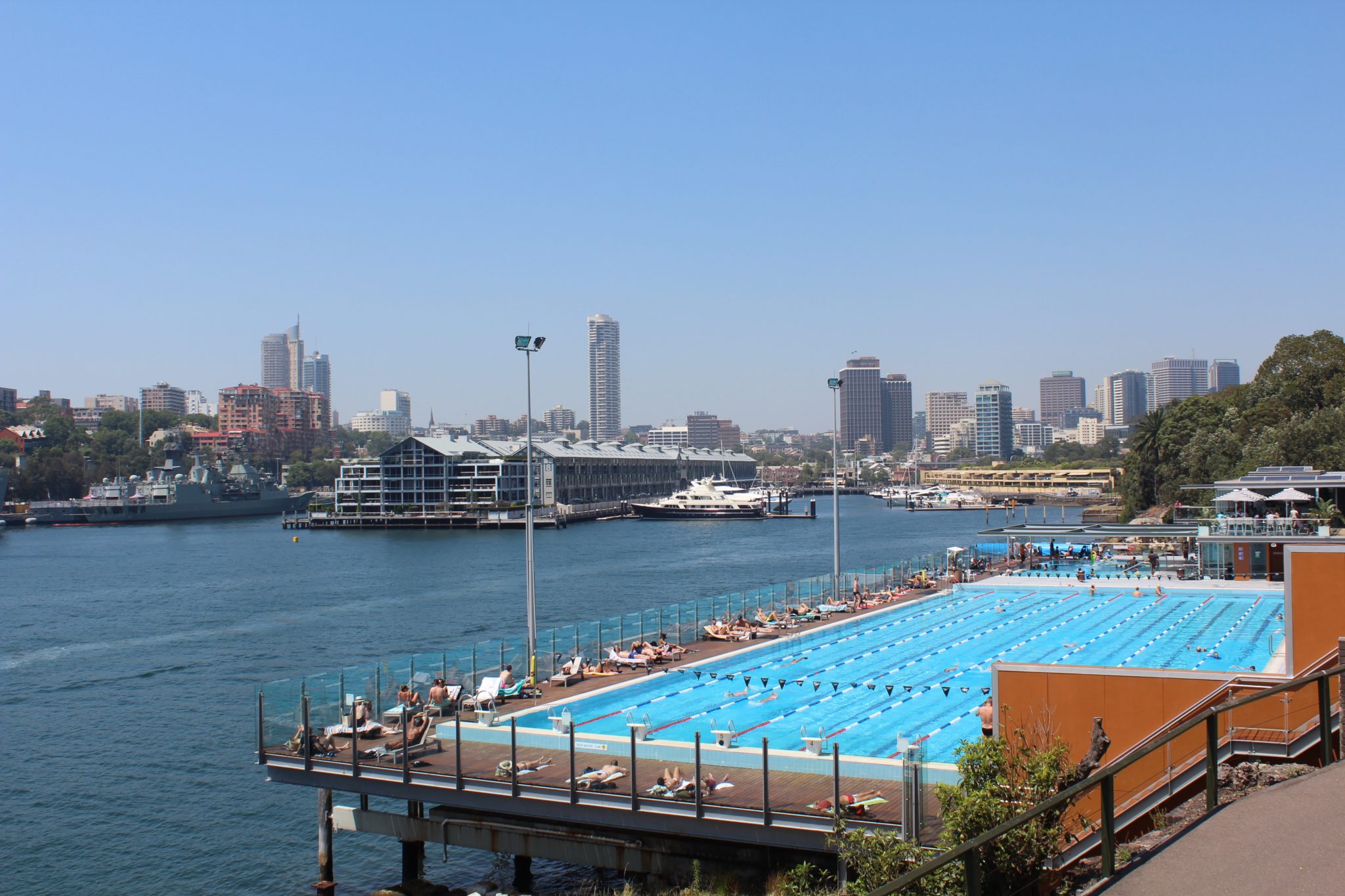
Andrew “Boy” Charlton Pool
Andrew “Boy” Charlton pool is where the beautiful people of Kings Cross and Darlinghurst come to bronze themselves and be seen. Cruisey summer by the pool? More like cruising by the Cross. It’s not all buffed bodies and shelf bums. But there’s a lot of it.
Tip: Hit the gym before you come here. Competition is real.
Price: $6.20
Mahon Pool, Maroubra

Mahon Pool, Maroubra
Set further from the beach than most of Sydney’s other rockpools, Mahon Pool at maroubra is a destination for those who want their surf without the surf. Waves come crashing in, stirring up the water, but the swimmers keep on swimming unperturbed. It sure beats the rough maroubra swell down at the beach.
Tip: Mahon Pool is lit for night swimming. Just try it once – you’ll be hooked!
Price: Free
Bronte Baths
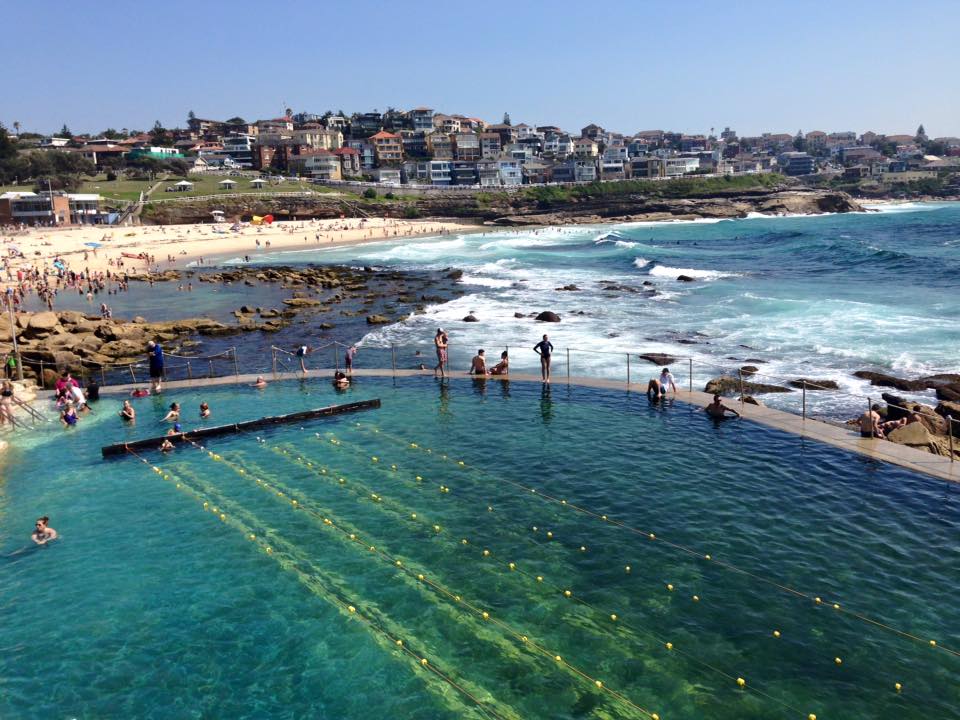
Bronte Baths
It’s like someone transported a crystalline piece of South Pacific aquamarine into the azure surf and sunshine yellow beach, such is the beauty of the Bronte baths. This is not any ordinary Rockpool – this is managed, gated and preserved. A little piece of heaven.
Tip: Sunbaking on the rocks next to the path above the pool is simply bliss
Price: Free
Bondi Icebergs
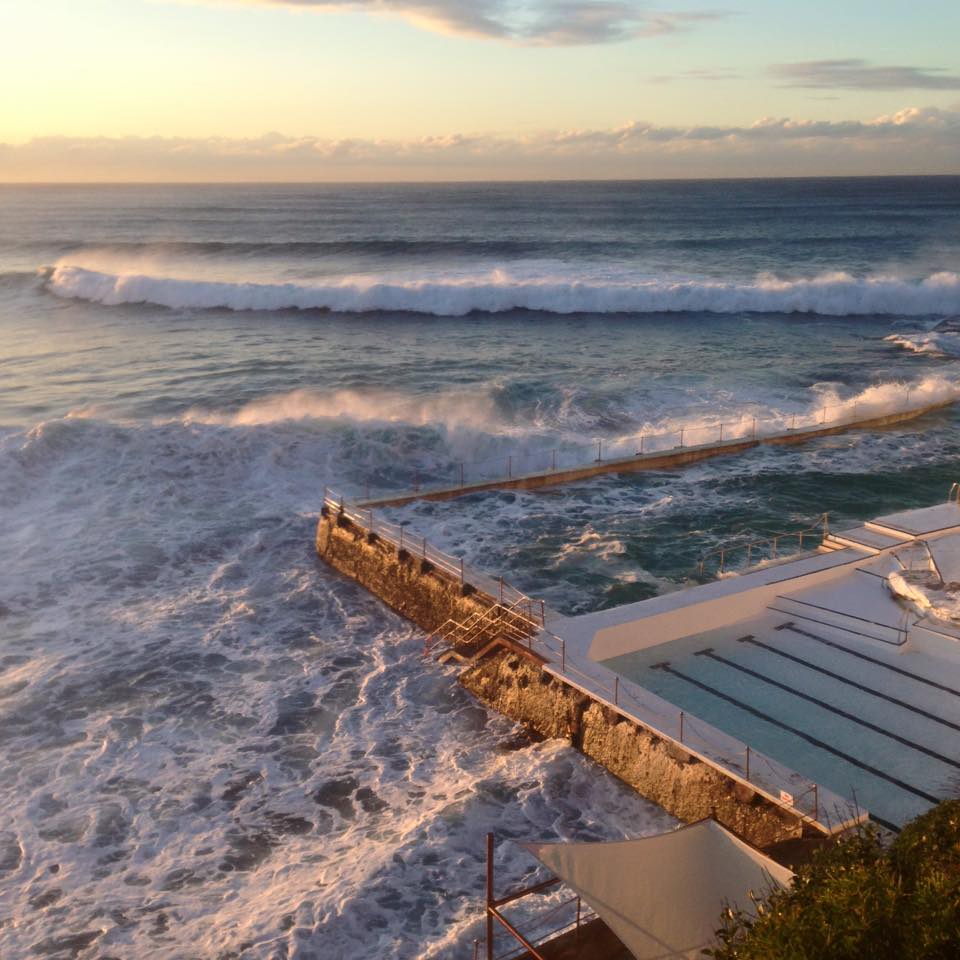
Bondi Icebergs
This is where they apparently put ice blocks in the water for the regulars’ cold temperature endurance training! Bondi icebergs is sort of the ultimate Sydney rockpool – the iconic beach, the iconic swimming hole… getting thrown into the drink as waves crash over the edge…
Tip: Come here early on a winter morning, watch the sun rise and see how the icebergs push the limits of their endurance.
Price: $6.50
MacCallum Pool
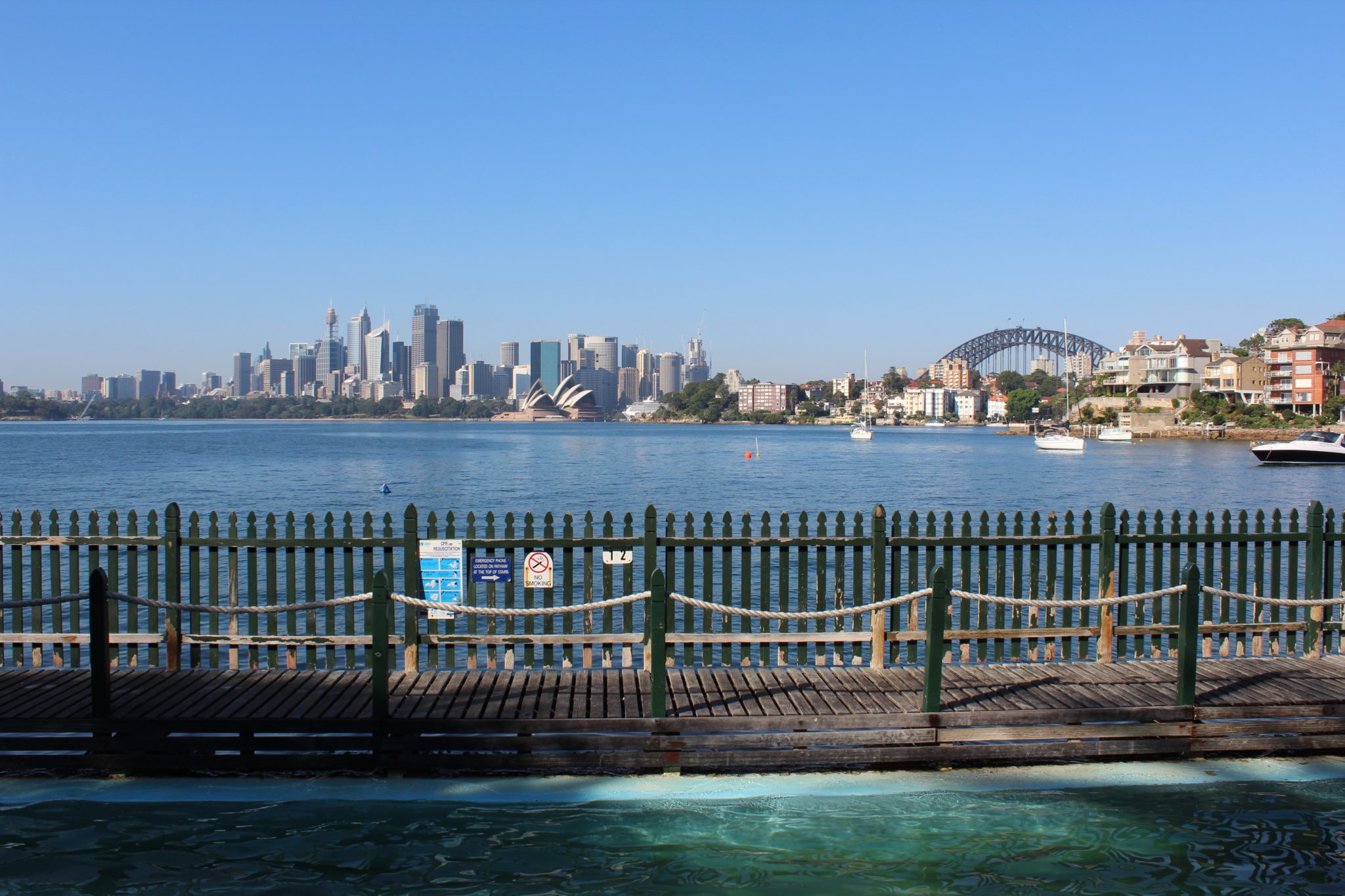
MacCallum Pool, Cremorne Point
If you’ve ever wanted to swim in Sydney Harbour (and really feel like you’re swimming in the harbour), this is the place to do it. Filtered harbour water in calm, forested surroundings tucked away on Cremorne Point. Peer over the boardwalk for picture postcard views of the Opera House.
Tip: Come here early in the morning and you might even have it to yourself – you’ll feel like you’ve just woken up in your very own Blue Lagoon film.
Price: Free
Lake Parramatta
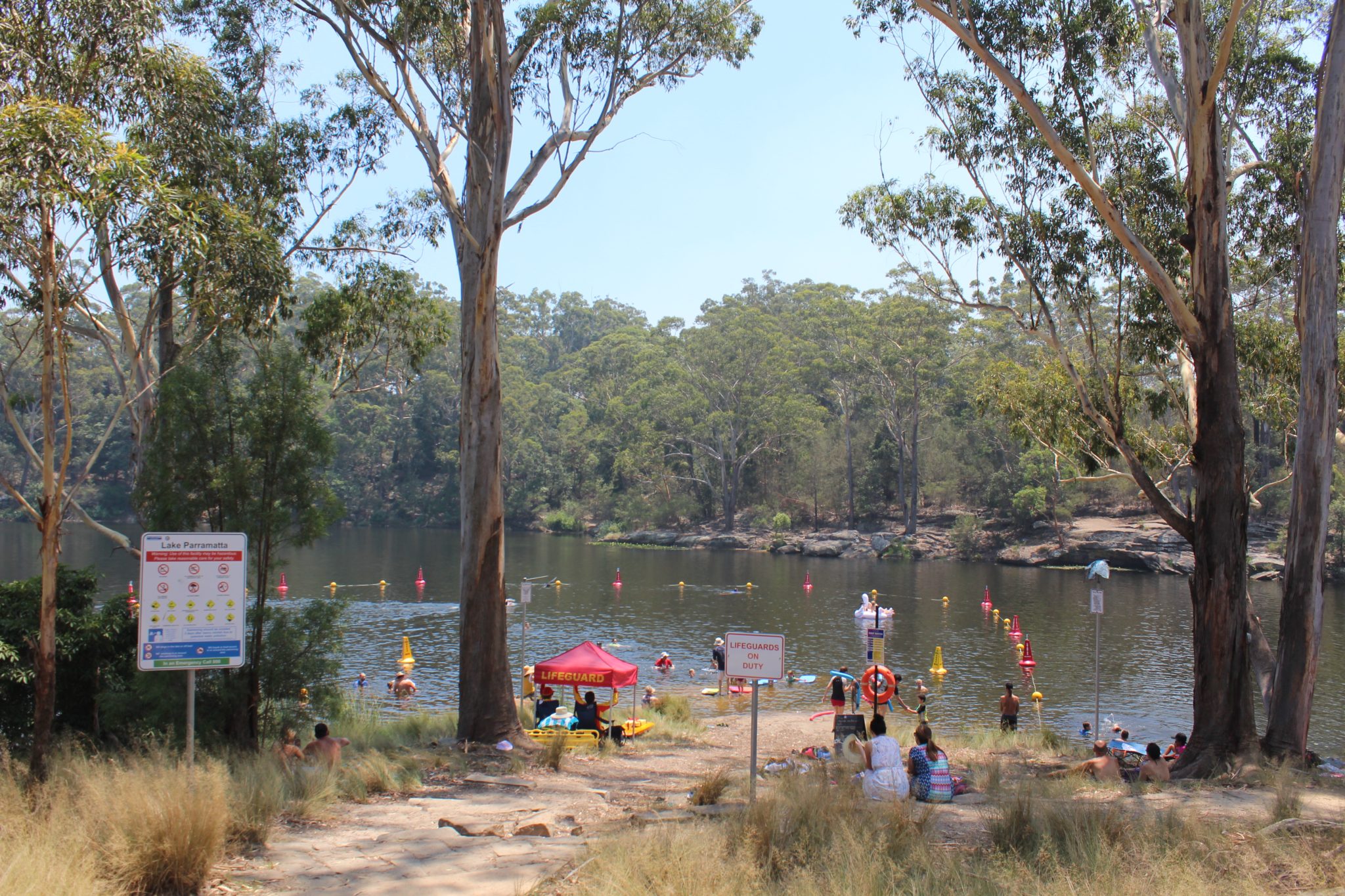
Lake Parramatta
Who’d have thought that parramatta would have one of Sydney’s best natural swimming holes? Ok, so it’s not technically a swimming pool, but it is a waterhole and it’s awesome. 20kms from the coast, and recently reopened after years of contamination, Lake Parramatta is possibly western Sydney’s best place to cool off this summer
Tip: Outside of the netted area you swim at your own risk; there are boats on lake parramatta, and you’re supposed to dip in the netted area full of children, where the lifeguards can keep watch. When I visited, some locals were having a ball jumping off the rocks on the northern shore of the lake. Technically out of bounds… But no one was stopping them either…
Price: Free
Sydney Olympic Park Aquatic Centre
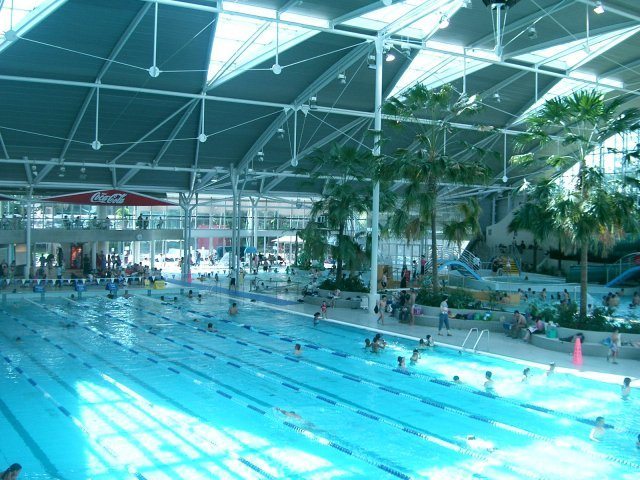
Sydney Olympic Park Aquatic Centre (Image: edwin11, Wikimedia Commons)
Anyone who grew up in Sydney in the late 1990s begged their parents to take them here at least once. The draw cards of course were the waterslide, the whirlpool, the hot tubs, kiddies area. Well guess what? It still rocks!
Tip: This is a great place for children, especially younger children. If you went swimming here as a child back in the 90s, and you’ve spawned some of your own, do the right thing and bring them here!
Price: $7.50
Wet’n’wild
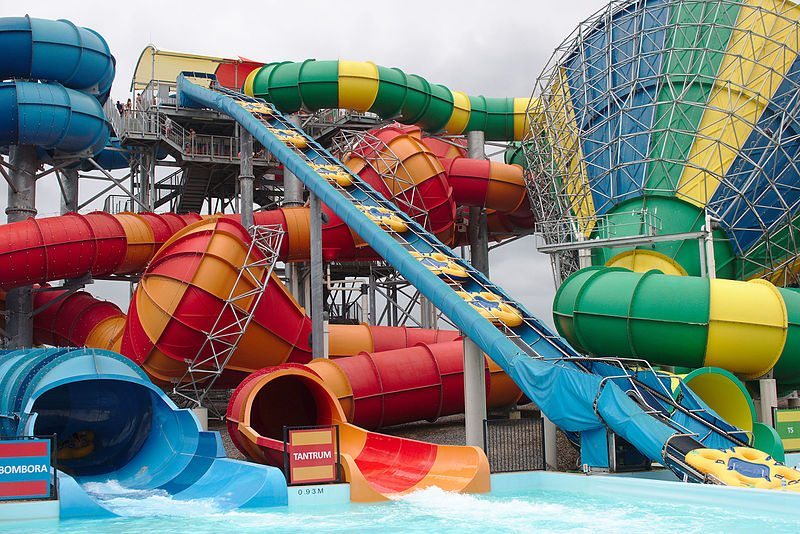
Wet n Wild Sydney (Image: Mary and Andrew, Wikimedia Commons)
Sydney does the Gold Coast! It was probably inevitable that the old Wonderland site would be used as some sort of a leisure venue, but it’s fair to say not many people saw it coming when in 2012, wet n wild announced their expansion into the Sydney market. 42 slides across four towers, each with a different level of intensity. What more could we want?
Tip: The park isn’t open all the time, especially during cooler months – check ahead of time, and book your tickets online.
Price: $79
What is your favourite swimming pool? (either in Sydney, or elsewhere)
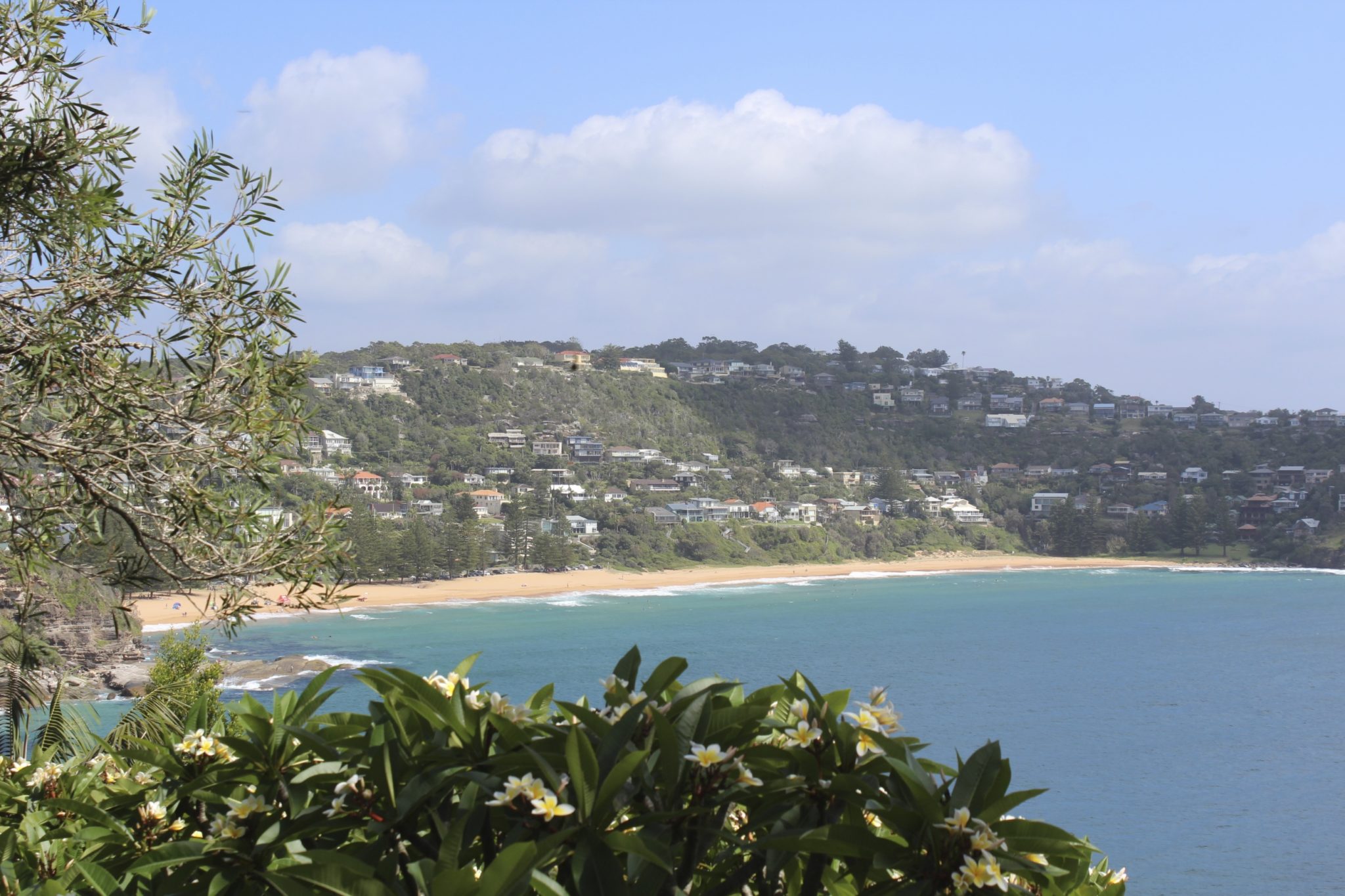
by Tim Blight | Dec 9, 2015 | Traveller
Sydney’s best beaches
So what are Sydney’s best beaches? As we head into another long hot summer, it’s time to nominate our favourite places to chill out in Australia’s biggest city.
Bondi Beach
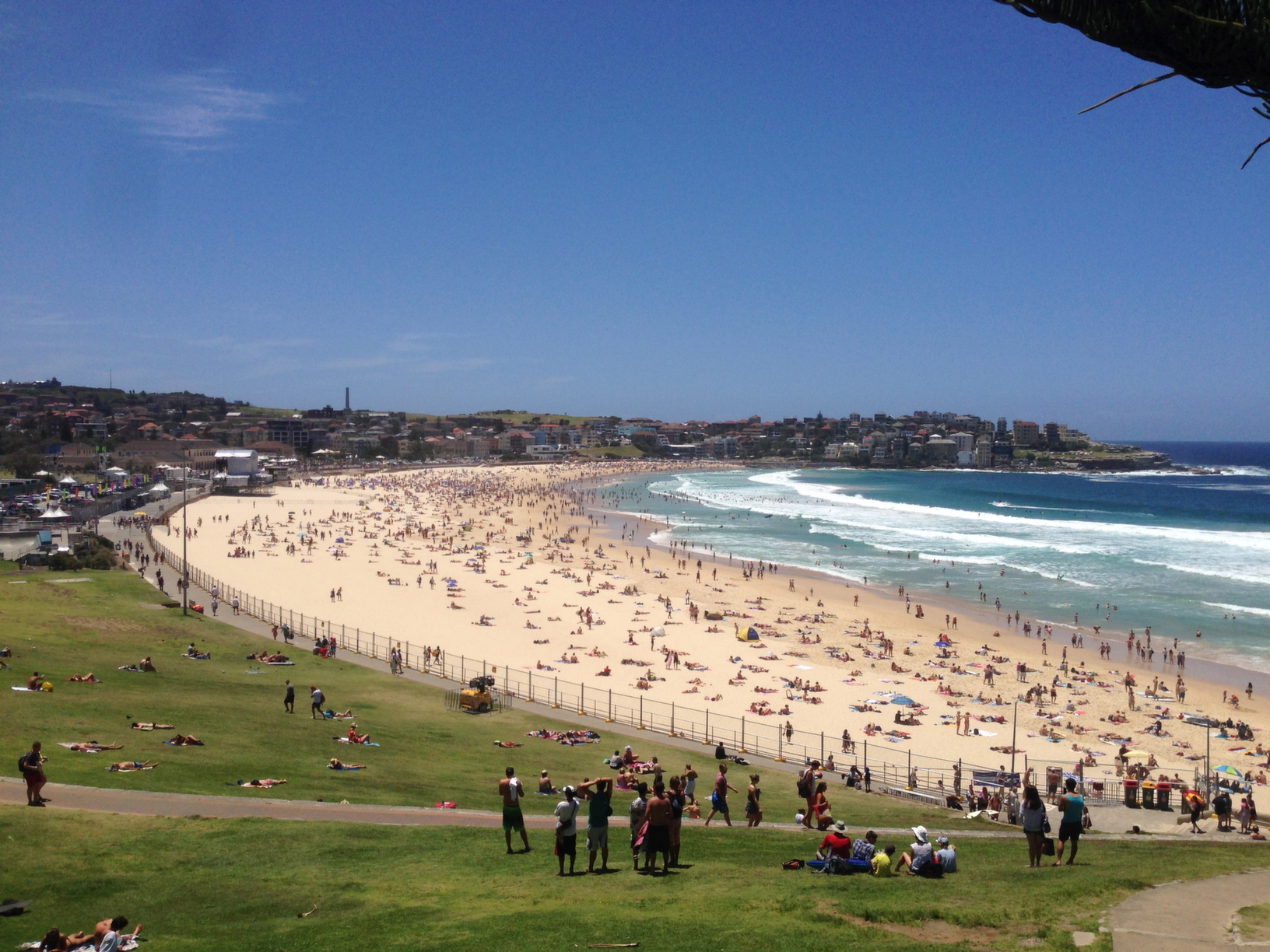
Bondi Beach
What would a beach article be if we didn’t mention Bondi? Sure it’s crowded, busy, and, dare we say it, overrated. But It still has much to recommend it. Where else can you lie on a stretch of sand this beautiful, then have a meal at such a wide selection of restaurants, go shopping, or even head back to work after your lunch break? While it’s no doubt pretty, even on a busy day, Bondi trumps anywhere else in terms of accessibility, facilities and backpacker party atmosphere.
Clovelly Beach
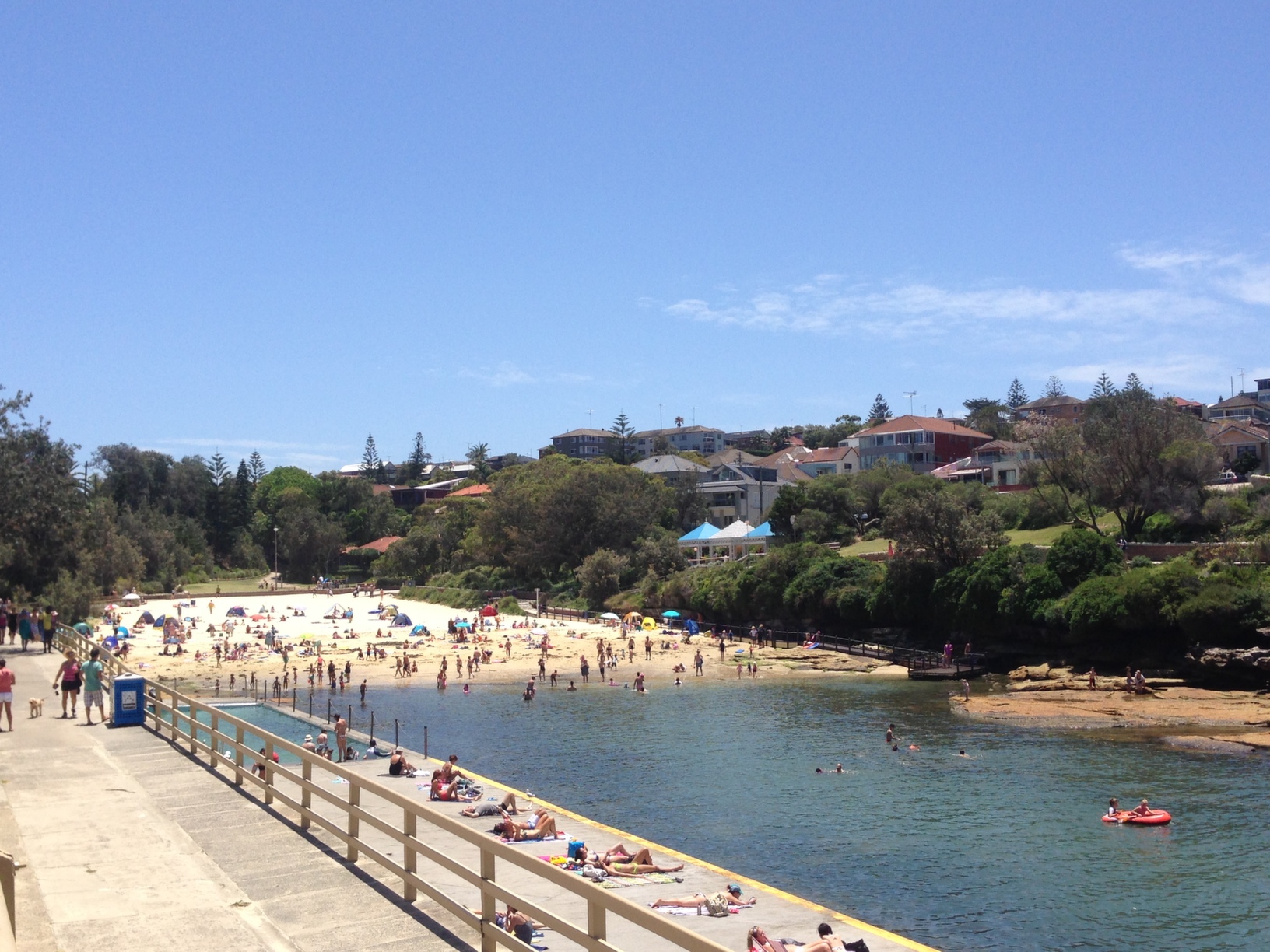
Clovelly’s cute beach and bay
Lovely little Clovelly is an anomaly in Sydney; a very short but deep beach at the end of a rocky inlet (while most beaches are long, wide and flanked by headlands). The waves break far out from the beach, creating a tight lagoon-like environment between the coast and the actual shoreline. The concrete catwalks which line the channel provide additional sun-baking space, while little waves race past into the narrow bay. The beach is backed by a small park, surrounded by trees that make Clovelly a perfect little antidote to the rush of other cityside beaches.
Whale Beach

Whale Beach
A secluded stretch of sand lined by Norfolk Island Pines and ringed by well-to-do villas boasting frangipani trees. No, this is not some faraway South Pacific idyll, this is Whale Beach, just south of more-famous Palm Beach and absolutely part of Australia’s largest city. Not that you’d know it; hidden from busy Barrenjoey Road by a range of green hills (hinterland?), Whale Beach sees far fewer visitors than its neighbours, and the locals like it this way.
Bilgola Beach
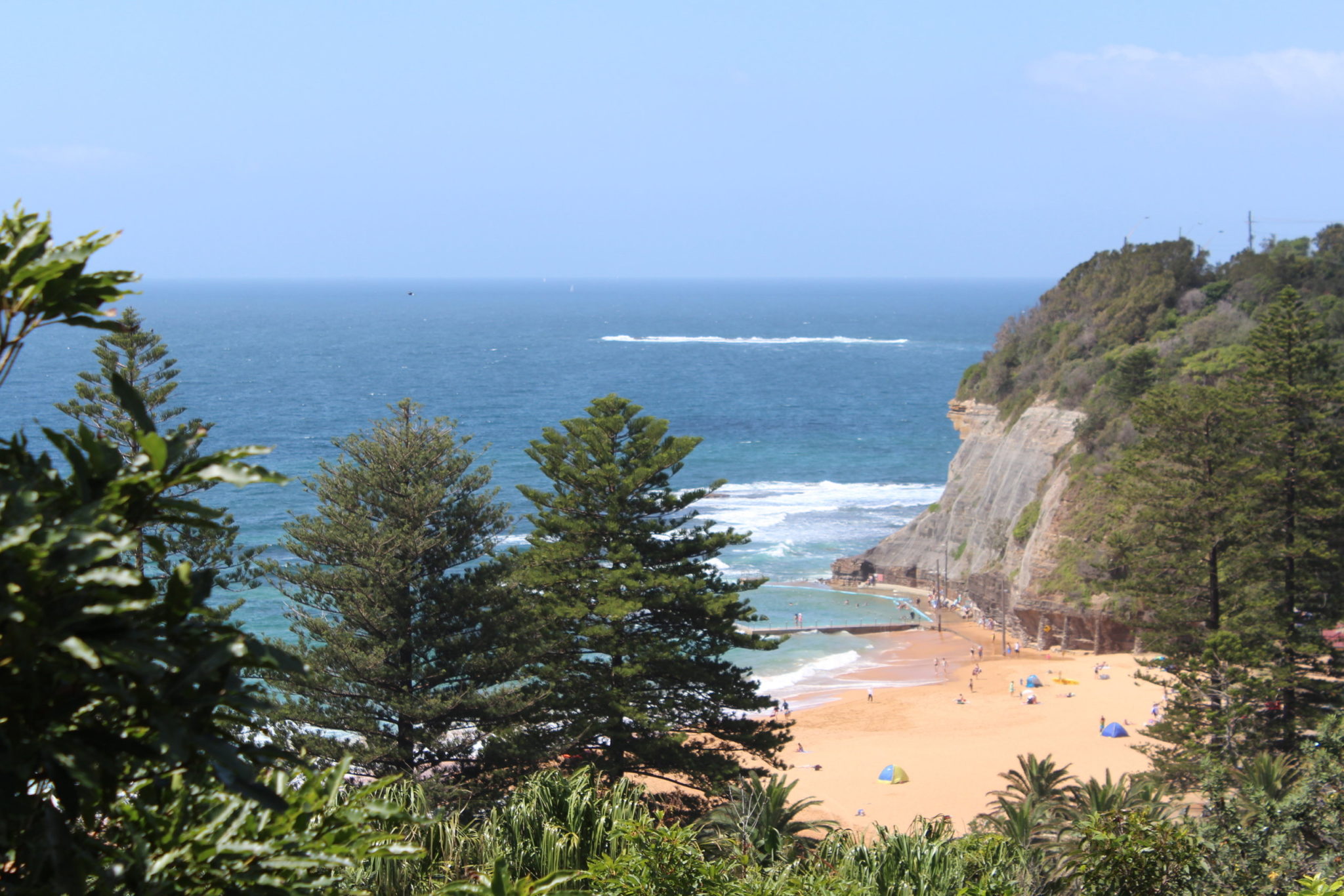
Bilgola Beach
It’s hard not to like a beach whose only land access route is a snaking, tree-lined road called The Serpentine. Once you’ve parked amid the palm groves, Bilgola Beach delights with its gorgeous little crescent of golden sand, and it’s pretty, secluded setting away from major traffic routes. It’s rarely crowded here, and there are properties right on the beach too – a low key slice of northern beaches beachfront, and a place you’ll find yourself returning to again and again.
Shelly Beach
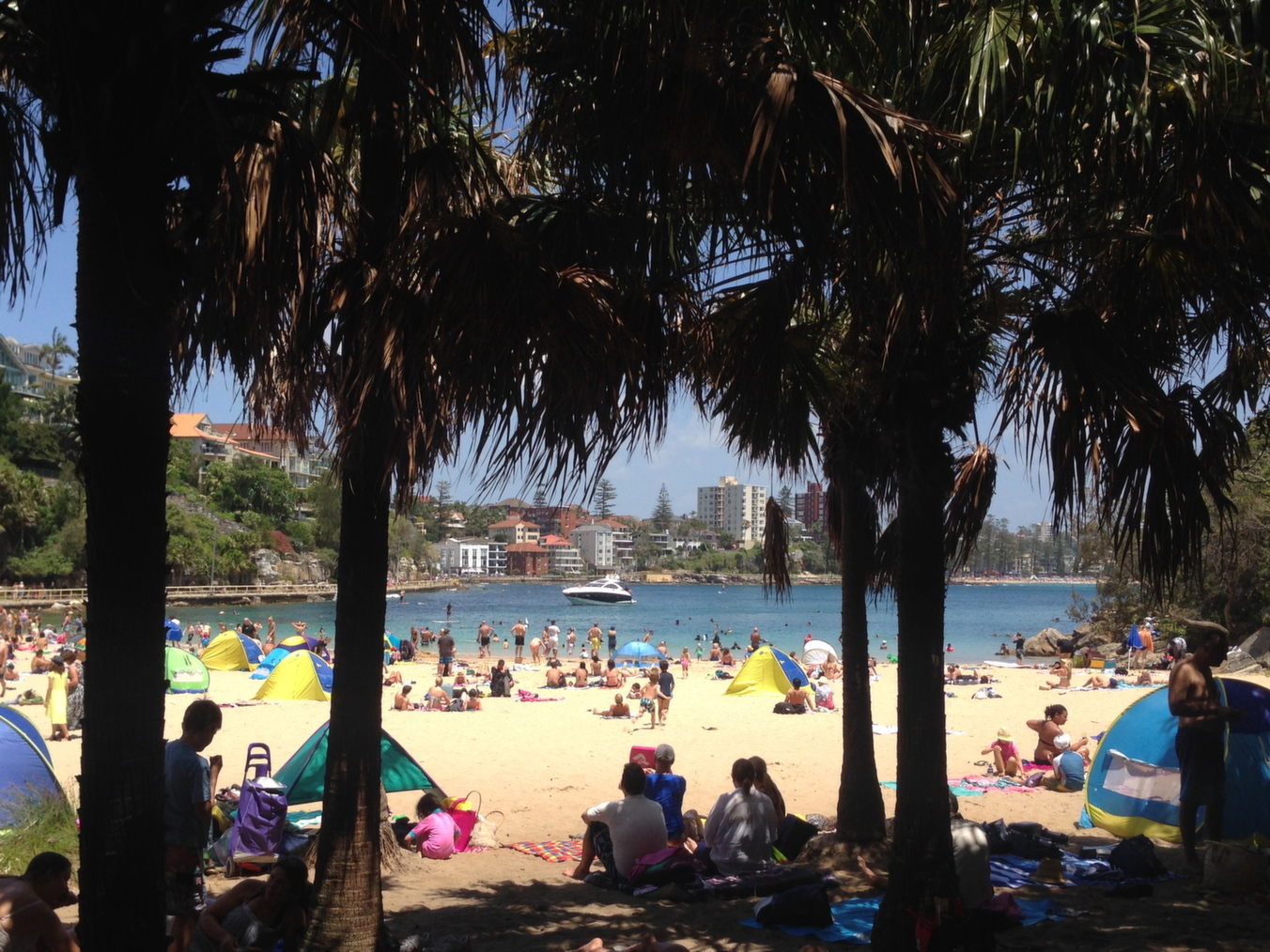
Shelly Beach
Ok, so it’s not actually part of the harbour, but lovely little Shelly Beach just around the headland from Manly is not exactly your typical ocean beach either. Come to this protected cove any warm weekend and you’ll see lots of families, paddle boarders and snorkelers enjoying the placid waters. Palm fringed, cafe-boasting and accessed by a long walk where you can spot wild water dragons, Shelly Beach is a long-time favourite for many Sydneysiders.
Balmoral Beach
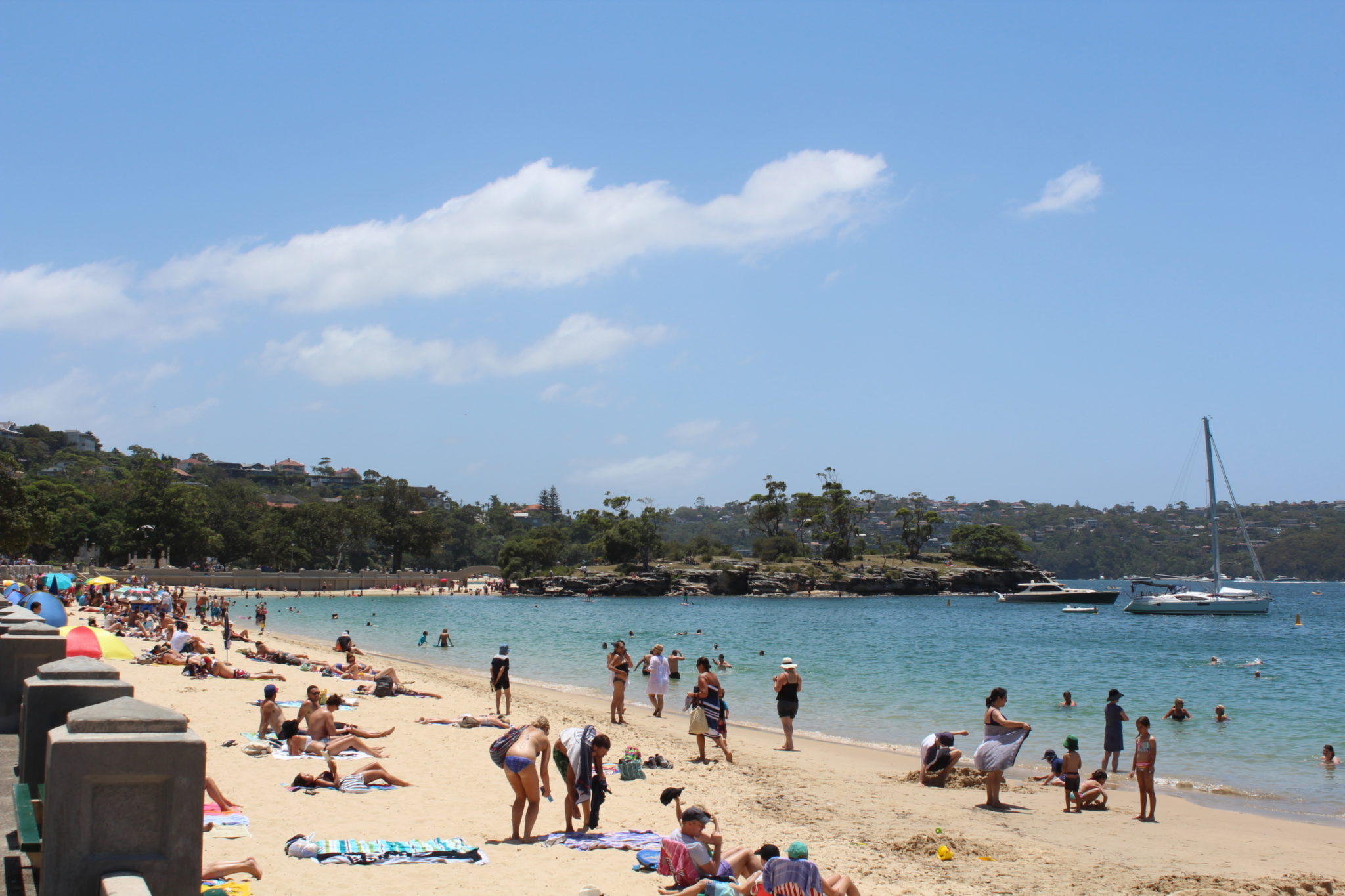
Balmoral Beach and its island
Balmoral is so much more than just a beach; it’s a suburb, it’s a destination, and it’s a state of mind. Despite the throngs of people who crowd the waterfront in peak season, it never quite loses its charm. With a handful of cute cafes, high-end shops and it’s gorgeous pavilion, it’s difficult not to love Balmoral. Spend time on the calm beach, walk across the quaint bridge over to the natural island, or while away the hours sipping a cool iced coffee.
What’s your favourite Sydney beach? Comment below!
This article is based on a series “Sydney’s Best Beaches, Parts One, Two and Three“, originally published in the summer of 2013/14.








